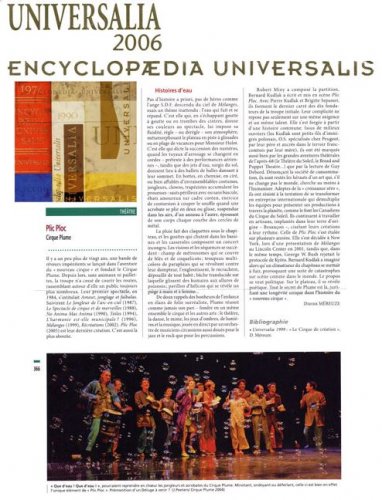Encyclopédie Universalis : Universalia 20065 March 2006
Plic Ploc Cirque Plume
Didier Méreuze
 A little over twenty years ago, a band of unrepentant dreamers set out on an adventure and founded the Cirque Plume. With no animals and no glitter, the nouveau cirque troupe has never stopped touring since, gathering around it an audience that continues to grow. Their first show in 1984 was entitled Amour, jonglage et falbalas. This was followed by Le Jongleur de l’arc-en-ciel (1987), Le Spectacle de cirque et de merveilles (1988), No Anima Mas Anima (1990), Toiles (1994), L’harmonie est-elle municipale ? (1996), Mélanges (1999), and Récréation (2002). Plic Ploc (2005) is their latest production. It is also the most accomplished.
A little over twenty years ago, a band of unrepentant dreamers set out on an adventure and founded the Cirque Plume. With no animals and no glitter, the nouveau cirque troupe has never stopped touring since, gathering around it an audience that continues to grow. Their first show in 1984 was entitled Amour, jonglage et falbalas. This was followed by Le Jongleur de l’arc-en-ciel (1987), Le Spectacle de cirque et de merveilles (1988), No Anima Mas Anima (1990), Toiles (1994), L’harmonie est-elle municipale ? (1996), Mélanges (1999), and Récréation (2002). Plic Ploc (2005) is their latest production. It is also the most accomplished.
Stories of Water
There is no obvious plot, no hero like the homeless angel descended from the sky in Mélanges. But there is an unexpected theme: water. It is water, leaking and spilling, water trickling down and gushing onto coat hangers, that gives the show its fluidity and color. It is water that forms – and deforms – its atmosphere, as the stage transforms from a water slide into a beach worthy of a holiday with Monsieur Hulot. It is water that dictates the series of acts, as watering hoses turn into suspended ropes - a pretext for aerial performances - while water jets, springing from the ground, give rise to juggling balls that dance in the air. Wearing boots, shirts, oilskins, or incredible costumes, jugglers, clowns, and trapeze artists carry out one feat after another: somersaults, Korean teeterboard love fests, and breathtaking contortion exercises as an acrobat folds herself in half, gliding through the air from one hoop to another, marrying her body to every curve of their metal rings.
Rain drops tap-dance under the big top, dribbling into basins and pots and forming an incongruous concert. A sequence of visual scenes unfolds: a field of metronomes covered with wheat and poppies; a multicolored flock of umbrellas rebelling against their tamer — swallowing him up, stripping him of all clothing, spitting him out; humans sliding like fish down a tarp; a tuba bell that traps women and hands.
From sweet reminders of childhood joys to surrealist madness, Plume succeeds as never before in its gamble: to merge circus and other arts into a single ensemble, mixing theater, dance, mime, lighting, shadows, and music. The latter is played live by an orchestra of circus musicians who shift with ease between jazz, percussion, and rock.
Robert Miny composed the score, and Bernard Kudlak wrote and directed Plic Ploc. Together with Pierre Kudlak and Brigitte Sepaser, they are the remaining four of the troupe’s ten original founders. Their complicity is based on more than matching talents and a common call to action. It was forged from a common history. Coming from working-class backgrounds (the Kudlaks are grandsons of Polish immigrants – workers at Peugeot – on their father’s side, and are rooted in the Franche-Comté region on their mother’s side), they were marked as much by the great theatrical adventures of the post-68 period (Théâtre du Soleil, Bread and Puppet Theater) as by the writings of Guy Debord. Denouncing consumer society, they have remained heralds of an art form which, if it doesn’t change the world, at least seeks to humanize it. Adherents of the degrowth movement, they have resisted the temptation to become an international company with multiple teams presenting its productions around the world, like the Canadians of Cirque du Soleil. They continue to work as artisans in their hometown, Besançon, chiseling their artistic works at their own pace. Plic Ploc was created across several years. The idea was decided upon in New York during a run of Mélanges at Lincoln Center in 2001, just as George W. Bush was rejecting the Kyoto Protocol. Bernard Kudlak imagined an air conditioner leaking in the tent, causing a series of disasters on stage and around the world. This is a political statement. On stage, it becomes poetry. All of Plume’s secret is right there, justifying its unique longevity in the history of nouveau cirque.









